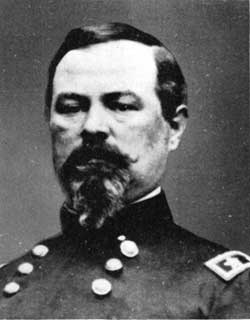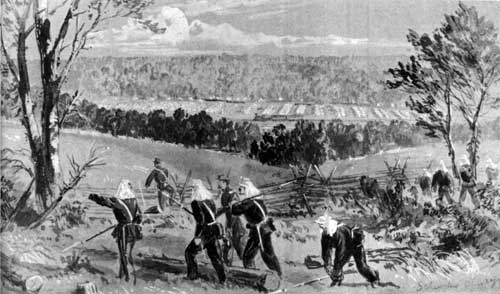|
MANASSAS National Battlefield Park |
 |
The Federal Army Moves Toward Manassas
 Brig. Gen. Irvin McDowell, in command of the Federal Army in the First Battle of Manassas. Courtesy National Archives. |
On July 16, Brig. Gen. Irvin McDowell had reluctantly put the Federal army in motion. In vain he had attempted to delay the movement until adequate training could provide him with an effective fighting force composed of the 3-year volunteers, authorized by President Lincoln on May 3, but popular clamor would not be denied. Pressure for a forward movement was heightened by the realization that the term of enlistment was rapidly expiring for a large body of the troops. Further delay would mean the loss of their services.
With excitement and high expectancy, the army, accompanied by many notables in fine carriages, took the road 35,000 strong. Seldom had the country seen such a splash of color as was presented by the brilliant uniforms of the various regiments and the gaily fluttering national and regimental flags. The first day's advance covered only 6 miles. Oppressive heat, dust, thirst, and the weight of heavy equipment slowed the step and caused considerable straggling.
Lagging spirits, however, caught fire with the triumphant advance of Hunter's division into Fairfax Court House. As the head of the column swung into town, Confederate units stationed there fled in such haste as to leave large quantities of forage and camp equipage behind. In an impressive show of martial splendor, the troops, four abreast with fixed bayonets, paraded through the streets to the stirring strains of the national anthem and other patriotic airs struck up by the regimental bands.
From Fairfax Court House the advance moved cautiously toward Centreville, with engineers and axmen flung forward to alert the army to "masked batteries" and to clear roadblocks of fallen timber left by the retiring Confederates. By noon of the 18th the main body of McDowell's army had assembled at Centreville and now stood poised to strike.

Federal Army near Fairfax Court House en route to
the First Battle of Manassas. A detachment of the 2d Ohio is shown in
the foreground.
From original sketch by A. R. Wand. Courtesy Library
of Congress.
During the advance, little or no information had been received regarding Patterson's movements in the valley. Irked by this, Scott telegraphed Patterson as follows:
Washington, July 18, 1861.
Major-General Patterson, . . .
I have certainly been expecting you to beat the enemy. If not, to hear that you had felt him strongly, or, at least, had occupied him by threats and demonstrations. You have been at least his equal, and, I suppose, superior, in numbers. Has he not stolen a march and sent reenforcements toward Manassas Junction? A week is enough to win victories. . . .
WINFIELD SCOTT
To this, Patterson sent the following reply to Colonel Townsend in Scotts' headquarters:
CHARLESTOWN, VA., July 18th, 1861
Col. E. D. Townsend:
Telegram of to-day received. The enemy has stolen no march upon me. I have kept him actively employed, and by threats and reconnaissances in force caused him to be re-enforced. I have accomplished in this respect more than the General-in-Chief asked, or could well be expected, in face of an enemy far superior in numbers, with no line of communication to protect. . . .
R. PATTERSON, . . .
The events of the next few days more than justified Scott's suspicions.

|

|
|
Last Modified: Sat, Apr 7 2001 10:00:00 am PDT |


